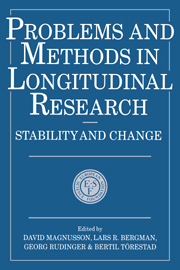Book contents
- Frontmatter
- Contents
- Contributors to this volume
- Foreword
- Preface
- 1 Studying individual development: problems and methods
- 2 Modeling individual and average human growth data from childhood to adulthood
- 3 Intraindividual variability in older adults' depression scores: some implications for developmental theory and longitudinal research
- 4 Now you see it, now you don't – some considerations on multiple regression
- 5 Differential development of health in a life-span perspective
- 6 Assessing change in a cohort-longitudinal study with hierarchical data
- 7 Statistical and conceptual models of ‘turning points’ in developmental processes
- 8 Qualitative analyses of individual differences in intra- individual change: examples from cognitive development
- 9 Application of correspondence analysis to a longitudinal study of cognitive development
- 10 Event-history models in social mobility research
- 11 Behavioral genetic concepts in longitudinal analyses
- 12 Genetic and environmental factors in a developmental perspective
- 13 Structural equation models for studying intellectual development
- 14 Longitudinal studies for discrete data based on latent structure models
- 15 Stability and change in patterns of extrinsic adjustment problems
- Index
7 - Statistical and conceptual models of ‘turning points’ in developmental processes
Published online by Cambridge University Press: 27 April 2010
- Frontmatter
- Contents
- Contributors to this volume
- Foreword
- Preface
- 1 Studying individual development: problems and methods
- 2 Modeling individual and average human growth data from childhood to adulthood
- 3 Intraindividual variability in older adults' depression scores: some implications for developmental theory and longitudinal research
- 4 Now you see it, now you don't – some considerations on multiple regression
- 5 Differential development of health in a life-span perspective
- 6 Assessing change in a cohort-longitudinal study with hierarchical data
- 7 Statistical and conceptual models of ‘turning points’ in developmental processes
- 8 Qualitative analyses of individual differences in intra- individual change: examples from cognitive development
- 9 Application of correspondence analysis to a longitudinal study of cognitive development
- 10 Event-history models in social mobility research
- 11 Behavioral genetic concepts in longitudinal analyses
- 12 Genetic and environmental factors in a developmental perspective
- 13 Structural equation models for studying intellectual development
- 14 Longitudinal studies for discrete data based on latent structure models
- 15 Stability and change in patterns of extrinsic adjustment problems
- Index
Summary
INTRODUCTION
During recent years there has been a growing interest in what have been termed transitions or ‘turning points’ in a person's development or life course (see, e.g., Elder, Caspi & Burton, 1988; Hareven, 1978; Maughan & Champion, in press; Rutter, 1989). The focus is on two main types of everyday events or happenings that bring about a potential for long-term psychological change. First, there are those in which the potential stems from an opening up or closing down of opportunities. Going to university and dropping out of school respectively provide obvious examples. Secondly, there are those that involve a radical lasting change in life circumstances. Such changes may come about as a result of key additions or subtractions from a person's nexus of intimate family relationships (as with marriage or divorce), or from alterations in life pattern (as from the transition to parenthood or being made redundant in midlife), or from a major social change stemming from a geographical move (as with immigration to a different country or a move from a metropolis to a rural village). The general concept is easy to understand and the operational definition of potential turning points is also straightforward, with the proviso that it is necessary to consider whether the events actually changed opportunities or life circumstances in the individual case. Thus, marriage may, but need not, involve a major change in social network, pattern of relationships or way of life.
Information
- Type
- Chapter
- Information
- Problems and Methods in Longitudinal ResearchStability and Change, pp. 133 - 165Publisher: Cambridge University PressPrint publication year: 1991
Accessibility standard: Unknown
Why this information is here
This section outlines the accessibility features of this content - including support for screen readers, full keyboard navigation and high-contrast display options. This may not be relevant for you.Accessibility Information
- 45
- Cited by
